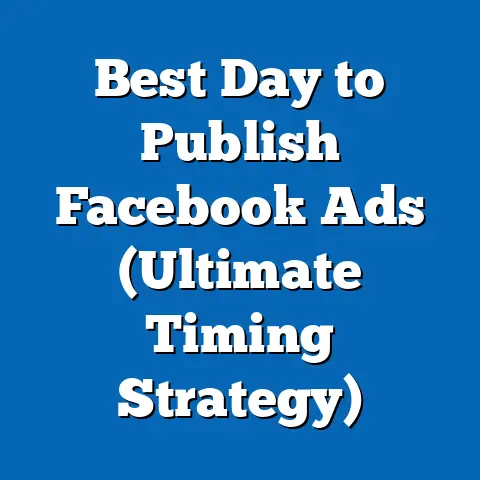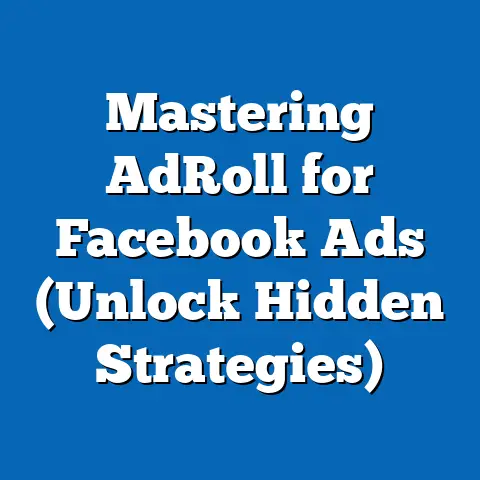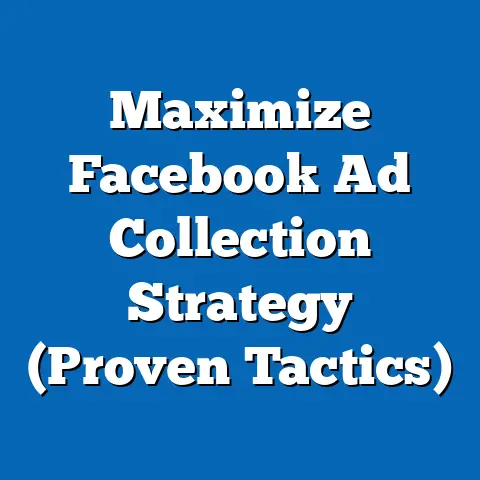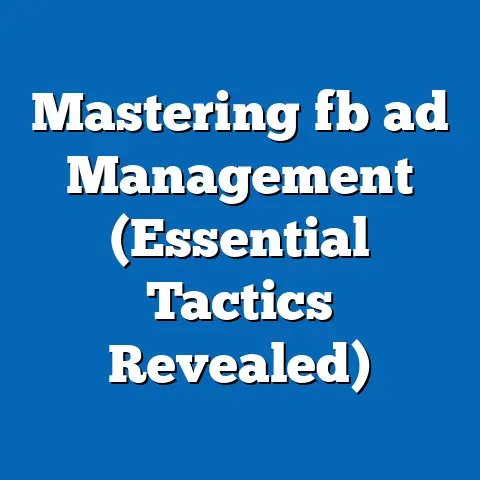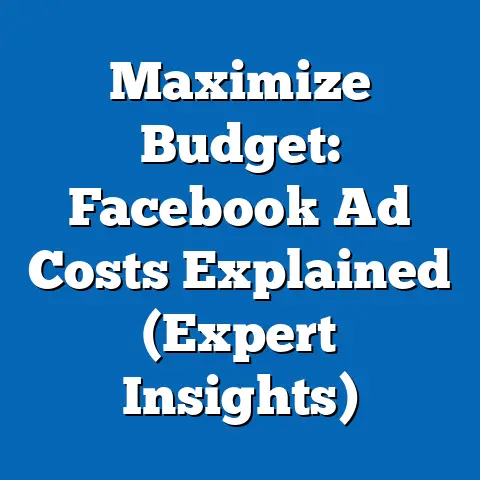Boost Facebook Marketplace Ads Today (Expert Strategies)
Why did the marketer break up with the calendar? Because it had too many dates! But when it comes to Facebook Marketplace ads, timing really is everything! I’ve seen firsthand how a well-timed and strategically crafted ad can transform a struggling product into a best-seller. In this article, I’m going to share the expert strategies I’ve learned over the years that can help you effectively boost your Facebook Marketplace ads and reach a wider, more engaged audience.
Facebook Marketplace has become a significant player in the eCommerce landscape, and the importance of advertising on this platform is only increasing. If you’re not leveraging its potential, you’re leaving money on the table. My goal is to equip you with the knowledge and practical steps you need to not only create effective ads but to truly make them shine, attracting the right buyers and driving sales.
Understanding Facebook Marketplace
Facebook Marketplace is a digital storefront within the Facebook platform, designed to facilitate peer-to-peer commerce. It’s where individuals and businesses can buy, sell, and trade goods – everything from furniture and electronics to clothing and even vehicles. Think of it as a virtual garage sale meets classified ads, all within the social network where billions of people already spend their time.
The demographics of Facebook Marketplace users are incredibly diverse, which is one of its biggest strengths. You’ll find everyone from young adults looking for a bargain on used furniture to families searching for baby gear and even entrepreneurs selling handmade crafts. This broad reach means that almost any product has a potential audience on the Marketplace.
Understanding user behavior on the platform is also crucial. Users typically browse the Marketplace with a specific intent – they’re actively looking for something. This means that your ads are reaching people who are already in a buying mindset, which significantly increases the likelihood of a conversion. They might be searching for keywords related to your product, browsing categories, or even checking out items their friends have listed.
It’s important to distinguish between organic listings and paid ads on Facebook Marketplace. Organic listings are free and appear based on relevance to a user’s search query. They rely on strong product descriptions and attractive images to stand out. Paid ads, on the other hand, allow you to target specific demographics and interests, increasing the visibility of your products to a wider audience. Think of it this way: organic listings are like setting up a stall at a local market, while paid ads are like having a billboard in the middle of town. Both have their place, but paid ads provide a much more powerful way to amplify your reach.
Key Takeaway: Facebook Marketplace is a powerful platform with a diverse user base actively looking to buy. Understanding the difference between organic listings and paid ads is the first step to maximizing your success.
Setting Up Your Facebook Marketplace Ads
Creating an effective ad for Facebook Marketplace requires careful planning and attention to detail. I’ve seen too many businesses throw up ads without considering the key elements, and they end up wondering why they’re not getting results. Here’s a breakdown of the steps to create an ad that truly stands out:
-
Choosing the Right Category: This might seem obvious, but it’s crucial to place your product in the most relevant category. If you’re selling a vintage lamp, don’t list it under “Electronics.” Accurate categorization ensures your ad reaches users who are specifically browsing for items like yours.
-
Crafting Compelling Product Descriptions: Your product description is your sales pitch. It should be clear, concise, and engaging. Highlight the key features and benefits of your product. Avoid generic descriptions and focus on what makes your item unique. Use keywords that potential buyers are likely to search for. For example, instead of just saying “Leather Jacket,” try “Vintage Brown Leather Motorcycle Jacket – Men’s Size Large – Excellent Condition.”
-
Selecting High-Quality Images: Images are the first thing potential buyers will see, so make them count. Use high-resolution photos that showcase your product from multiple angles. Good lighting is essential. Avoid blurry or pixelated images. If possible, include a photo of the product in use. For example, if you’re selling a coffee table, stage it in a living room setting to give buyers a sense of its size and style.
-
Competitive Pricing: Pricing is a critical factor in attracting buyers. Research similar products on the Marketplace and price your item competitively. Consider offering a slight discount to entice buyers. Be realistic about the value of your product. While you want to make a profit, overpricing your item will likely deter potential customers. I’ve found that offering a small discount or free shipping can often be the deciding factor for buyers.
Choosing the Right Category: This might seem obvious, but it’s crucial to place your product in the most relevant category. If you’re selling a vintage lamp, don’t list it under “Electronics.” Accurate categorization ensures your ad reaches users who are specifically browsing for items like yours.
Crafting Compelling Product Descriptions: Your product description is your sales pitch. It should be clear, concise, and engaging. Highlight the key features and benefits of your product. Avoid generic descriptions and focus on what makes your item unique. Use keywords that potential buyers are likely to search for. For example, instead of just saying “Leather Jacket,” try “Vintage Brown Leather Motorcycle Jacket – Men’s Size Large – Excellent Condition.”
Selecting High-Quality Images: Images are the first thing potential buyers will see, so make them count. Use high-resolution photos that showcase your product from multiple angles. Good lighting is essential. Avoid blurry or pixelated images. If possible, include a photo of the product in use. For example, if you’re selling a coffee table, stage it in a living room setting to give buyers a sense of its size and style.
Competitive Pricing: Pricing is a critical factor in attracting buyers. Research similar products on the Marketplace and price your item competitively. Consider offering a slight discount to entice buyers. Be realistic about the value of your product. While you want to make a profit, overpricing your item will likely deter potential customers. I’ve found that offering a small discount or free shipping can often be the deciding factor for buyers.
Example: I once helped a client who was struggling to sell handmade jewelry on Facebook Marketplace. Their initial ads had lackluster descriptions and poor-quality photos. We revamped their ads with detailed descriptions highlighting the craftsmanship and unique materials used, and we took professional-looking photos showcasing the jewelry on models. We also adjusted the pricing to be slightly below the competition. The result? Sales increased by over 300% in just a few weeks.
Key Takeaway: A well-crafted ad with a clear description, high-quality images, and competitive pricing is the foundation for success on Facebook Marketplace.
Expert Strategies to Boost Your Ads
Once you’ve set up your ads, it’s time to take them to the next level with these expert strategies:
Strategy 1: Targeting the Right Audience
Facebook’s audience targeting features are incredibly powerful. You can target users based on location, interests, demographics, and even behaviors. The key is to create buyer personas to better understand your potential customers. A buyer persona is a semi-fictional representation of your ideal customer, based on market research and data about your existing customers.
For example, if you’re selling baby clothes, you might target parents of young children who are interested in parenting, baby products, and related topics. You can also target users who have recently had a baby or who are expecting.
Tip: Don’t just rely on broad categories. Dive deep into the available targeting options. For example, instead of just targeting “Parents,” you could target “Parents of children aged 0-12 months” who are interested in “Organic baby food” and “Sustainable baby clothing.”
Strategy 2: Utilizing Facebook Ad Insights
Facebook Ad Insights provides a wealth of data about the performance of your ads. You can track key metrics such as engagement rates, click-through rates (CTR), and conversion rates. Analyzing this data is essential for refining your ad strategies.
- Engagement Rate: This measures how many people are interacting with your ad (likes, comments, shares). A high engagement rate indicates that your ad is resonating with your audience.
- Click-Through Rate (CTR): This measures how many people are clicking on your ad to view your product. A high CTR indicates that your ad is attracting attention and driving traffic to your listing.
- Conversion Rate: This measures how many people are actually purchasing your product after clicking on your ad. A high conversion rate indicates that your ad is effectively driving sales.
Tip: Regularly monitor your Ad Insights and make adjustments to your ads based on the data. If you notice that your CTR is low, try experimenting with different ad copy or images. If your conversion rate is low, review your product listing to ensure it’s clear, concise, and persuasive.
Strategy 3: Leveraging Seasonal Trends and Events
Aligning your ads with seasonal trends, holidays, or local events can significantly boost their visibility. For example, if you’re selling Halloween costumes, you’ll want to ramp up your advertising efforts in the weeks leading up to Halloween. Similarly, if there’s a local festival or event in your area, you can target users who are attending the event with ads for related products.
Example: I once helped a client who owned a local bakery capitalize on a popular local event. We created ads targeting people attending the event with special offers on their baked goods. We even geo-targeted the ads to only show to people within a certain radius of the event. The result was a huge increase in foot traffic to their bakery and a significant boost in sales.
Strategy 4: Crafting Compelling Ad Copy
Your ad copy is your opportunity to persuade potential buyers to click on your ad and purchase your product. It should be clear, concise, and engaging. Highlight the key benefits of your product and create a sense of urgency.
- Use strong headlines: Your headline is the first thing people will see, so make it attention-grabbing.
- Highlight key benefits: Focus on what your product can do for the buyer.
- Create a sense of urgency: Use words like “Limited Time Offer” or “While Supplies Last” to encourage immediate action.
- Include a clear call-to-action: Tell buyers exactly what you want them to do (e.g., “Shop Now,” “Learn More,” “Message Seller”).
Tip: Use power words to make your ad copy more persuasive. Power words are words that evoke emotion and create a sense of excitement or urgency. Examples include “Amazing,” “Exclusive,” “Guaranteed,” and “Free.”
Strategy 5: Experimenting with Ad Formats
Facebook Marketplace offers a variety of ad formats, including:
- Single Image Ads: These are the most basic type of ad and feature a single image or video.
- Carousel Ads: These allow you to showcase multiple images or videos in a single ad.
- Collection Ads: These are designed to showcase a collection of products in a visually appealing format.
- Video Ads: These can be highly engaging and are a great way to showcase your product in action.
Experiment with different ad formats to see what works best for your products and target audience. For example, if you’re selling clothing, carousel ads can be a great way to showcase different outfits or styles. If you’re selling a complex product, a video ad can be a great way to explain its features and benefits.
Key Takeaway: Don’t just set it and forget it! Continuously experiment with different targeting options, ad copy, and ad formats to optimize your ads for maximum performance.
Budgeting and Bidding Strategies
Setting a budget for your Facebook Marketplace ads is crucial for managing your advertising spend. You can choose between a daily budget, which is the average amount you’re willing to spend each day, or a lifetime budget, which is the total amount you’re willing to spend over the entire duration of your ad campaign.
Tip: Start with a small daily budget and gradually increase it as you see results. This allows you to test different ad strategies without risking a large amount of money.
Facebook also offers different bidding strategies, including:
- Cost-Per-Click (CPC): You pay each time someone clicks on your ad.
- Cost-Per-Impression (CPM): You pay for every 1,000 times your ad is shown.
The best bidding strategy for you will depend on your goals and budget. If you’re focused on driving traffic to your listing, CPC might be the best option. If you’re focused on increasing brand awareness, CPM might be a better choice.
Example: I often recommend starting with CPC bidding, especially for businesses new to Facebook Marketplace advertising. This allows you to directly measure the cost of each click and optimize your ads based on the results. Once you have a better understanding of your audience and ad performance, you can experiment with CPM bidding.
Key Takeaway: Choose a budgeting and bidding strategy that aligns with your goals and budget. Start small and gradually increase your spend as you see results.
Optimizing Your Ads Over Time
The key to long-term success on Facebook Marketplace is continual optimization. Don’t just set up your ads and forget about them. Regularly monitor their performance and make adjustments based on the data.
Here’s a checklist for ongoing ad evaluation:
- A/B Testing: Test different variations of your ad copy, images, and targeting options to see what performs best.
- Ad Insights Analysis: Regularly monitor your Ad Insights to track key metrics such as engagement rates, CTR, and conversion rates.
- Competitive Analysis: Keep an eye on what your competitors are doing and adjust your strategies accordingly.
- Adapt to Changes: Facebook’s advertising policies and algorithms are constantly changing, so stay up-to-date on the latest trends and best practices.
Tip: Don’t be afraid to experiment. The best way to find out what works is to try different things and see what happens.
Example: I’ve seen countless businesses transform their Facebook Marketplace ad performance simply by consistently A/B testing different elements of their ads. Even small changes, like a different headline or a slightly different image, can have a significant impact on results.
Key Takeaway: Continual optimization is essential for long-term success on Facebook Marketplace. Regularly monitor your ad performance, experiment with different strategies, and adapt to changes in Facebook’s advertising policies and algorithms.
Conclusion
Utilizing expert strategies is essential for enhancing your Facebook Marketplace ad performance. By understanding your audience, crafting compelling ads, and continually optimizing your campaigns, you can reach a wider audience, drive more traffic to your listings, and ultimately, increase your sales.
I encourage you to take action today to implement these strategies and watch your sales grow. Don’t be afraid to experiment and try new things. The world of online selling is constantly evolving, so it’s important to stay up-to-date on the latest trends and best practices.
In the world of online selling, the best time to start was yesterday. The second-best time is now! So, go out there and start boosting your Facebook Marketplace ads today!
Call-to-Action
I’d love to hear about your own experiences and strategies for boosting Facebook Marketplace ads. Share your tips and insights in the comments below. And be sure to follow my page for more expert tips on Facebook advertising!

